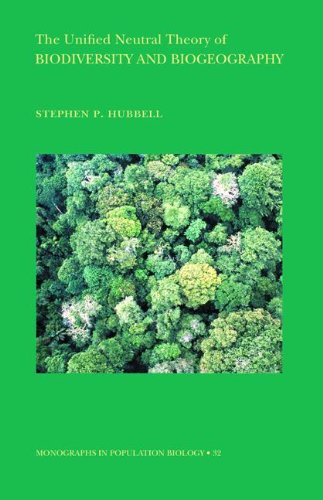The Unified Neutral Theory of Biodiversity and Biogeography (MPB-32) (Monographs in Population Biology)



Product Description
Despite its supreme importance and the threat of its global crash, biodiversity remains poorly understood both empirically and theoretically. This ambitious book presents a new, general neutral theory to explain the origin, maintenance, and loss of biodiversity in a biogeographic context.
Until now biogeography (the study of the geographic distribution of species) and biodiversity (the study of species richness and relative species abundance) have had largely disjunct intellectual histories. In this book, Stephen Hubbell develops a formal mathematical theory that unifies these two fields. When a speciation process is incorporated into Robert H. MacArthur and Edward O. Wilson's now classical theory of island biogeography, the generalized theory predicts the existence of a universal, dimensionless biodiversity number. In the theory, this fundamental biodiversity number, together with the migration or dispersal rate, completely determines the steady-state distribution of species richness and relative species abundance on local to large geographic spatial scales and short-term to evolutionary time scales.
Although neutral, Hubbell's theory is nevertheless able to generate many nonobvious, testable, and remarkably accurate quantitative predictions about biodiversity and biogeography. In many ways Hubbell's theory is the ecological analog to the neutral theory of genetic drift in genetics. The unified neutral theory of biogeography and biodiversity should stimulate research in new theoretical and empirical directions by ecologists, evolutionary biologists, and biogeographers.
</p>The Unified Neutral Theory of Biodiversity and Biogeography (MPB-32) (Monographs in Population Biology) Review
A couple of years ago, Dr. Jim Brown (Univ. New Mexico) wrote an article in the National Center for Ecological Analysis and Synthesis (NCEAS) website indicating that he had not seen any really significant new ideas in ecology during the last few year. Well, we have one.In the hierarchy of biological systems, ecology deals with the highest and most complex levels. Explanation for patterns of abundance and distribution of organisms have been either too specific that only applies to a few species or even one, or too general that can not be tested (remember the ghost of competition's past).
Ecologists working at the community level have mostly been guided by the general principle that interactions tend to determine the diversity of communities. On the larger scale of biogeography, researchers considered that local diversity tends to be a function of a regional species pool. This debate became very contested in the early 1980's and continued for almost a decade, without any meaningful progress. Nonetheless, significant achivements in both areas of inquiry were made.
Hubbell takes advantage of the increased large-scale reasearch in community ecology (like the Smithsonian-MAB biodiversity network of plots) coupled with the ever more manipulative and reductionist approach to biogeography. Is important to add here Hubbell's own contribution to biodiversity research is substantial. Furthermore, the originality of the work is what sets this monograph appart from the last few in the series. The application of random walk models (i.e., ecological drift) to the organization of communities is not a truly new approach. What make is unique is that then he incorporates immigration and extinction rates across space (classical MacArthur-Wilson), and can then predict a range of abundances and distributions. He supplies ample data from tropical systems that agree with model's predictions. The more interesting aspect is when the data doesn't agree. Here there is plenty of productive work to be performed.
One point that Hubbell makes concerning the "triviality" of the nuetrality assumption. Can there be cases when the differential survival of individuals lead to deviations from the theory's prediction? I think that the assumption of neutrality is not as trivial as Hubbell makes it.
Overall, is probably one of the most intriguing and original works of the last decade. If you are interested in ecology, biogeography, and even conservation, this book will challenge what you know and how should we look at patterns and process of biodiversity.
Most of the consumer Reviews tell that the "The Unified Neutral Theory of Biodiversity and Biogeography (MPB-32) (Monographs in Population Biology)" are high quality item. You can read each testimony from consumers to find out cons and pros from The Unified Neutral Theory of Biodiversity and Biogeography (MPB-32) (Monographs in Population Biology) ...

No comments:
Post a Comment